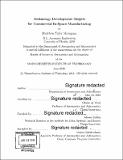| dc.contributor.advisor | Olivier de Weck and Afreen Siddiqi. | en_US |
| dc.contributor.author | Moraguez, Matthew Tyler | en_US |
| dc.contributor.other | Massachusetts Institute of Technology. Department of Aeronautics and Astronautics. | en_US |
| dc.date.accessioned | 2018-11-28T15:42:31Z | |
| dc.date.available | 2018-11-28T15:42:31Z | |
| dc.date.copyright | 2018 | en_US |
| dc.date.issued | 2018 | en_US |
| dc.identifier.uri | http://hdl.handle.net/1721.1/119308 | |
| dc.description | Thesis: S.M., Massachusetts Institute of Technology, Department of Aeronautics and Astronautics, 2018. | en_US |
| dc.description | Cataloged from PDF version of thesis. | en_US |
| dc.description | Includes bibliographical references (pages 121-125). | en_US |
| dc.description.abstract | In-Space Manufacturing (ISM) promises to revolutionize space systems by reducing mass, lowering costs, and enabling entirely new designs through the orbital fabrication of components in the space environment in which they are intended to operate for their entire life. Because ISM changes many long-standing launch-related design constraints, a new approach for the design and fabrication of space systems must be developed. Technology development planning for ISM is complicated by the existence of various proposed commercial ISM architectures, each with their own technologies, products, and costs. Instead of attempting to estimate these highly uncertain quantities, this analysis informs ISM technology targeting by identifying the key system drivers, maximum allowable lifecycle cost, and minimum required performance for an ISM architecture to be cost-effective relative to the existing launched approach. This analysis is accomplished by first forming generalized classes of ISM applications based on the design constraints relaxed using ISM, such as launch loads, fairing volume, standard gravity, and launch schedule. These generalized classes, which include structurally optimized systems, larger-than-launchable systems, Earth-return systems, and on-demand manufactured systems, are shown to be collectively exhaustive, but not mutually exclusive. For each of these classes, a bottom-up cost model is developed that captures the impact of key system drivers on lifecycle cost. Then, Buckingham Pi theorem is used to identify nondimensional groups of input design variables, such as the ratio of areal density of launched components to that of ISM components, the ratio of ISM facility mass to that of ISM components, the ratio of ISM product sale price to launch cost, or the ratio of launch cost to material cost. The breakeven point between launched and ISM components is identified as a function of these parameters and nondimensional groups, which serve as technology development targets for commercial viability. It is shown that the presented approach can inform technology development efforts by evaluating the commercial viability of historical, current, proposed, and notional ISM concepts across a broad application space. The best ISM applications can be identified as having a high allowable facility cost without requiring a large total ISM product mass. For the structurally optimized class, ISM of solar arrays appears promising because structural mass can be reduced by up to 85% relative to the technology goal for launched solar arrays. However, ISM solar array mass savings are fundamentally limited by solar cell mass, which can total 5 kg/kW. Of the Earth-return concepts considered, ISM of ZBLAN optical fiber appears most promising with an allowable facility cost of $1.35B based on just 125 kg produced over a five year period at its sale price of $11M/kg. The commercial viability of ISM of ZBLAN is relatively insensitive to launch costs. Interestingly, falling launch costs improve the business case of Earth-return ISM concepts, while weakening that of ISM for structural optimization. | en_US |
| dc.description.statementofresponsibility | by Matthew Tyler Moraguez. | en_US |
| dc.format.extent | 125 pages | en_US |
| dc.language.iso | eng | en_US |
| dc.publisher | Massachusetts Institute of Technology | en_US |
| dc.rights | MIT theses are protected by copyright. They may be viewed, downloaded, or printed from this source but further reproduction or distribution in any format is prohibited without written permission. | en_US |
| dc.rights.uri | http://dspace.mit.edu/handle/1721.1/7582 | en_US |
| dc.subject | Aeronautics and Astronautics. | en_US |
| dc.title | Technology development targets for commercial In-Space Manufacturing | en_US |
| dc.type | Thesis | en_US |
| dc.description.degree | S.M. | en_US |
| dc.contributor.department | Massachusetts Institute of Technology. Department of Aeronautics and Astronautics | |
| dc.identifier.oclc | 1061862512 | en_US |
